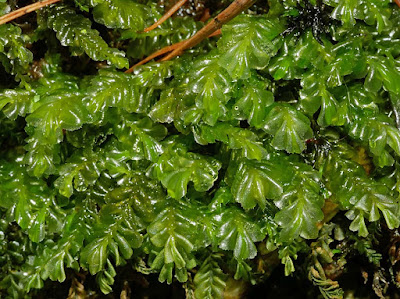There are four pots of winter-flowering violas on a table just outside our living room window. Most days, this wren visits, searching through the plants for something edible. As far as I can tell, it spends most of its time picking tiny aphids from the plants, using that curved, pointed bill with forensic dexterity.
Sunday, January 29, 2023
Thursday, January 26, 2023
Some lovely liverworts
This is probably the best time of year to look for liverworts, when they are actively producing new shoots and before taller vegetation grows up around them and often hides them in spring. Here are a few that I've found recently.
Plagiochila porelloides, Lesser Featherwort. A smaller, more compact Plagiochila species with darker green leaves. I found this one growing in crevices in a wet, shady retaining wall.
Metzgeria falcata, Forked veilwort, a small thalloid liverwort that I found growing on the bark of an old beech tree, at the point where rain trickles down the trunk. The thin, flat thallus forks near the tip.
Tuesday, January 24, 2023
Crows versus Magpies
Magpies have nested at the bottom of our garden annually for about twenty years. Until last year they returned every spring to the massive heap of sticks in the centre of an old hawthorn, which was well hidden. Last year they built a new one in a fast-growing Norway maple, about ten feet higher than their previous nest and very exposed to potential predators. A pair of magpies have been standing guard over the nest since late December, but now it looks as though they are being evicted by carrion crows.
A single crow turned up yesterday morning, pecking at twigs in the nest and evidently rearranging them for its own comfort. It provoked a furious and very noisy reaction from the magpies.
The magpies made a lot of fuss but never approached within pecking range of the crow's beak.
Sunday, January 15, 2023
Winter bloomer
Spurge laurel is a very easy plant to overlook unless it's in flower, because its glossy evergreen foliage has some resemblance to a small-leaved Rhododendron.
Click here for a post from 2014 about the Wolsingham plant and its pollinators.
The whole plant is poisonous, but despite its toxicity it was formerly used in what must have been very risky herbal medicine. This is what William Withering (who discovered the medicinal uses of foxglove) has to say about it in his Botanical Arrangement of all the Vegetables growing naturally in Great Britain, published in 1776: 'Very happy effects have been experienced from this plant in rheumatic fevers. It operates as a brisk and severe purgative. It is an efficacious medicine in worm cases; and upon many accounts deserves to be better known to physicians; but in less skilful hands would be dangerous, and it is possessed of considerable acrimony. The whole plant has the same qualities, but the bark of the root is the strongest. Dr. Alston fixes the outside dose at ten grains'.
(DON'T TRY THIS AT HOME!!!)
Tuesday, January 10, 2023
Some winter fungi
Not many big fungi around in my neck of the woods at this time of year, but plenty of interesting smaller ones.
This is yellow brain fungus Tremella mesenterica, a parasite on another fungus called Peniophora that grows on dead gorse stems.
These are ivory coral Ramariopsis kunzei, growing in a local Scots pine plantation
Tuesday, January 3, 2023
Goldfinches, alders and dandelions
It's hard to over-estimate how important alder seeds are as food for small finches in winter. Siskins love them, but so do goldfinches, like these that I watched on a walk near my home yesterday.


























































